August Spending:
Aug 1 - RMNP 80 miles - $8
Aug 2 - Pikes 280 miles - $13 ($20 from Carl)
Aug 4 - Track 25 miles - $2.50
Aug 11 - Track 25 miles - $2.50
Aug 14 - Pikes 280 miles - $32
Aug 15 - Food and stuff - $10
Aug 22 - Tank of gas to, from, at Leadville - $45
Aug 29 - Up to RMNP & back - $10
Aug 30 - Breckenridge Marathon reg - $55
Totals:
Spending .................. $178
Mileage ...................... 282
Spending per mile ... $0.63
YTD Totals
Dollars:
Jan ......... $456
Feb ......... $284
March ...... $30
April ........ $318
May ......... $498
June ........ $366
July ......... $106
August .... $178
To date .... $2,228
Miles:
Jan ................ 265 (33,000 feet)
Feb ................ 259.5 (40,350 feet)
March ........... 302 (32,050 feet)
April ............. 247.5 (31,300 feet)
May ............... 513 (67,000 feet)
June .............. 268 (46,150 feet)
July ............... 228 (50,650 feet)
August ........... 282 (56,700 feet)
To Date ......... 2,365 (357,00 feet)
Monthly ave .. 296 (44, 625 feet)
Spending per Mile: $0.94
The second upcoming event that I want to announce is Digital Architecture London, organized by Ruairi Glynn. That will take place on Monday, September 21st, at the Building Centre here in London. "Introducing the latest developments in digital design practice," we read, "the conference will explore new spaces, social interactions, design and fabrication processes, and speculate on architecture’s post-digital futures."  A related book – Digital Architecture: Passages Through Hinterlands – edited by Glynn and documenting the parallel exhibition, will be released the same day.
A related book – Digital Architecture: Passages Through Hinterlands – edited by Glynn and documenting the parallel exhibition, will be released the same day.
The program sounds amazing, and I'm really looking forward to this. The day's complete list of panelists looks like this: Rachel Armstrong, Tony Dunne, Marcos Cruz, and Rachel Wingfield will be discussing "Digital Architecture & Bio-Technology"; Usman Haque, Matt Webb, Tobi Schneidler, and Stephen Gage will look at "Digital Architecture & Interaction"; Brett Steele, Patrik Schumacher, Marjan Colletti, Alvin Huang, and Daniel Bosia will analyze "Digital Architecture & Form"; and Bob Sheil, Hanif Kara, Charles Walker, and Michael Stacey will discuss "Digital Architecture & Fabrication." I will be speaking on a panel featuring Alan Penn, Neil Spiller, and Murray Fraser, and our topic will be "Digital Architecture & Space."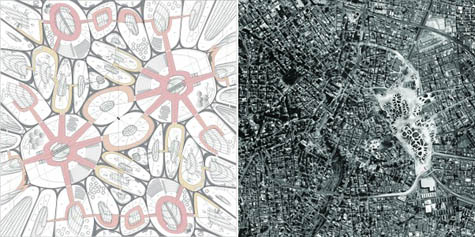 [Images: Two projects from the Hinterlands exhibition: (left) MatArc by Patrick Usborne, (right) Crackology by Mayhem].
[Images: Two projects from the Hinterlands exhibition: (left) MatArc by Patrick Usborne, (right) Crackology by Mayhem].
Information about venue, timing, tickets, and more can all be found on the conference website.
 This weekend in Lund, Sweden, Sir Peter Cook and Abelardo Gonzalez will be hosting the 2009 ASAE conference, the theme of which is Communicating Architecture.
This weekend in Lund, Sweden, Sir Peter Cook and Abelardo Gonzalez will be hosting the 2009 ASAE conference, the theme of which is Communicating Architecture.
- ASAE is an annual symposium at the School of Architecture, Lund University, Sweden. It celebrates the beginning of the academic year. This year's ASAE will be a two-day event with lectures, seminar, critique, exhibition and more.
Unfortunately, I'll be speaking first thing Saturday morning! But I'll be giving a talk called "Optioning Architecture." There will be at least two major themes to be developed:
- 1) What are the options available to architects when it comes to communicating spatial ideas? Are renderings, plans, and diagrams still the most communicationally effective media to use (from the perspective of the interested public) or simply the most industrially useful (from the perspective of fellow architects and contractors)? What happens when, say, Bernard Tschumi's next building is not announced to the public via well-rendered images and a press release but in the form of a novel? There is also much to discuss here by inverting this scenario and asking: what happens when novelists, screenwriters, poets, and so on begin creating buildings to communicate their literary and narrative ideas, instead of producing texts? While this obviously risks repeating the textualist arguments of an earlier decade, it still seems worth asking what might have happened if James Joyce, for instance, had been a junior architect at KieranTimberlake: what effect might his literary urges have had upon that firm's built output? Put another, slightly cheesy, way: if Mervyn Peake had been a successful architect, what strange and sprawling manor houses might now exist somewhere in the English countryside? In any case, what, in the end, are the communicational options available to architects?

- 2) What possibilities exist for "optioning architecture," in the sense that a book, short story, or screenplay can be "optioned" by Hollywood for production in another media? That is, what might happen to the world of architectural design if your final graduate thesis project was to be optioned by Steven Spielberg or David Fincher? Would this be similar, in some ways, to the relationship between Rem Koolhaas's co-authored graduate thesis project, "Exodus, or the Voluntary Prisoners of Architecture," and Rupert Thomson's under-appreciated novel Divided Kingdom? To what extent is the latter a novelization of the former? Finally, would it be possible for someone from DreamWorks to come along, see a new museum under construction in Chicago or Baltimore, and then option it, the way he or she might option a promising novel? Could you literally translate the spatial dynamism and implied narrative logics of a building – could you option them – into an act of mainstream cinema? How might such a process work – and is there a reason why this hasn't yet occurred (i.e. it would be a totally ridiculous thing to do)?
The complete conference line-up includes Florencia Pita, David Garcia, Drura Parrish, Megumi Matsubara, and Daniel Golling. Read more on the conference blog.
So I'm a little stiff and sore
in, ahem, all kinds of places.
I didn't get to go as fast as I would have liked mainly due to ALOT off walkers I had to battle my way past on the first leg of the run.
But I LOVED it.
The atmosphere was amazing. It was hard work. It was fun.
And I'm signing up for the half marathon for next year.
For those of you who are interested it took me 1 hour and 21 minutes to complete 12km. I can hear you doing the mental maths, I don't run fast, but I can cover long distances at a steady pace.
And one of the big lessons I learned from these past ten weeks is that when it comes to my fitness, there are no excuses.
If I can keep up a training regime whilst supporting my dad through major heart surgery, through my children having swine flu and you know 3rd degree burns, as well as working both full and part time, well you can too.
The fact that I coped with all those things is probably because I was getting fit.
I remember starting and doing two kilometers nearly killed me. But I persevered.
This isn't a call to arms by any means, but I urge you to find a sport you love or if you can't find one you love, instead find one you don't hate. And do it.
Because we all have struggles in our lives. And we all need time out. And sitting on the couch eating isn't the way to do it. Trust me on this. It has its place, but tragically, it's a very small place. In fact my doctor would say it has no place.
Seriously.
And I have to tell you, there are some BIG hills on this run and one of the things that kept me going was reciting the names written on the flower on my tshirt in my head.
Remembering them, and remembering you.
It gave me a reason to keep going and for that I thank you.
And now, in what is the ONLY time you will ever see my rear view
Kinda pretty don't you think?
The flower I mean....

BBC2's schedule webpage now confirms that episode 1 of the Last Chance To See TV series, featuring Stephen Fry and Mark Carwardine, is called "Amazonian Manatee", and will air on Sunday, September 6th at 8p.m. For all you UK viewers, enjoy. I've already got the DVD on order for my Region Free player, so I'll be a little behind with any thoughts on the shows.
Stephen Fry and zoologist Mark Carwardine head to the ends of the Earth in search of animals on the edge of extinction, following the route Mark took 20 years ago with the author Douglas Adams.
They set out to discover how the lugubrious Amazonian manatee, a freshwater mammal, has survived the last two decades, but Stephen breaks his arm deep in the Amazon rainforest.

Title picture and menu background for the Google Android version of the puzzle game Clockwiser.
Clockwiser is also a free online game.
More at Sevensheaven.nl

The Mummy traverse, or Mummy Mania as it is commonly called, is a peak-bagging trip across the north-eastern boundaries of Rocky Mountain National Park. The traditional route is to start at the Chapin Pass trailhead (10,600'), three quarters of the way up the Old Fall River Road, and follow the Mummy Range northeast, taking in six peaks along the way: Chapin (12,454'), Chiquita (13,069'), Ypsilon (13,514'), Fairchild (13,502'), Hagues (13,560'), and Mummy (13,426').Chad and I had been planning on running this route for quite some time, so we were pretty excited to finally be heading up to the Mummies when we met up at five on Saturday morning. We parked up at the Chapin trailhead and were ready to go by 6:15 or so. We had a super clear morning, and the early morning light from the east was as beautiful as ever.
From Chapin to Lawn Lake (with all six peaks) it is approximately 16 miles and 6,500' of climbing, with most of the work between 12,500' and 13'500'. We didn't have much beta on the footing, so assumed it would be a mix of tundra running, boulder hoping and climbing, which it pretty much was, but with way more boulder action than tundra - so to call this a 'run' would be a stretch of epic proportions. With the exception of the first mile or two of trail to Chapin Pass and the last 6 miles on the Lawn Lake Trail, this route is a solid hike. We put in a few token running efforts on some of the less boulder-strewn sections of tundra, but it was hardly worth the effort in terms of making time.
Setting out from the trailhead, it was a fairly steep climb on the trail that led straight to and up Mount Chiquita. Somewhere here we should have made a quick cut up to Mount Chapin, but missed it and ended up bagging Chiquita as our first peak. Chiquita was pretty straightforward, with an unmaintained cairn trail all the way to the summit.
The saddle between Fairchild and Hagues offered some respite (once off Fairchild) from scree and rock hopping, with some lush ground cover. The tundra was still littered with rock, however, which made running particularly hazardous. We soon gave up any hopes of serious running on the traverse and just settled in for a solid hike the rest of the way.
The actual climb up Mummy Mountain was pretty straightforward with plenty of rich red vegetation making the footing much easier than on the boulders that had been the main theme of the day.
After the big descent down Mummy on our red carpet, we hooked in with a drainage channel and made our way down to the Black Canyon Trail, where we could finally break out a full-on run. It felt great to be running, and we soon picked up the Lawn Lake Trail and ran the six miles down to the trailhead for a total outing time of 7:27.
I think it would have been touch and go on the record if we had taken in Chapin, although I am sure we would have pressed harder if it was in the cards. Once we realized, on Fairchild, that we had missed Chapin, we were fairly deflated, so pretty much decided from there to make it a solid hike on the day rather than push for any time goals. We'll do it up properly next time.
We hitched a ride back up the Old Fall River road from a sweet young couple from Ohio. Our original plan was to run the eight miles back, but then we had also thought we'd get the traverse done in under five hours, so opted to save our weary legs for another day.
Splits if you're interested:
Chaquita: 0:58
Ypsilon: 1:30
Fairchild: 2:59
Hagues: 4:15
Mummy: 5:24
Hit trail: 6:33
Lawn Lake TH: 7:27
Mon -- 11 miles (2,000'). 1:40. To Soderburg TH, up Towers, across Westridge, down Horsetooth, home. (Vas).
Tues:
noon - 6.5 miles (1,700'). Horsetooth Rock FKT attempt. 26:17 up, 17:36 down, 43:54 round trip. (CLs)
pm - 5 miles track. One mile warm up, then 1,600 @ 5:34, 800 (2:36), 200 easy, 400 (75), 200 easy, 400 (74), 400 easy, 800 (2:42), 200 easy, 400 (73), 200 easy, 400 (72). One mile cool down.
Weds - 8 miles easy on treadmill. (Vas)
Thurs - 14 miles (1,100') to JJs and back. 1:40. Two miles easy, then 10 miles at LT pace (31:40 down to JJs, 34:35 back up). It took me forever to get myself out the door for this one. Not only was it 90 degrees out, but the wind was blowing hard and all 14 miles were on the roads. For me this is the perfect storm of nastiness. Thought I would be able to get by without water, but was feeling dehydrated by about three miles into the run. Got home and weighed in at a puny 134.7. Within 20 minutes of rehydrating and eating I was up to 139. Tough run.
Fri - 8 miles easy(1,650'). Horsetooth/Audra. (Vas)
Sat - 16 miles (6,500'). Mummy Mania with Chad. (WCs).
Sun - 0 miles. Had planned an easy 20 on Blue Sky, but just wasn't feeling it.
Total: 69 miles (13,000').
Sunday was a bit of a disappointment, but also a realization that I can't be hammering the miles week in week out this late in an already long season. Beginning to feel that time goals for Dublin need to go out the window, so I can relax and enjoy the remainder of the good running weather without stressing about hitting mileage goals. The plan from here through October is to get a couple of quality workouts in each week and then run by feel for the remainder.
Audio
Arabian Prince – Innovative life – Stones Throw
Geiom – Reminissin’ (Kode9 refix) – Berkane Sol
Joy Orbison – Hyph mngo – Hot Flush
Paul White – Flying across Tokyo – One Handed Music
Paul White – Sugar free airlines – One Handed Music
Paul White – Surfing off the coast of Mexico – One Handed Music
Cloaks – Rust on metal – 3BY3
Mount Kimbie – Sketch on glass – Hot Flush
Blue Daisy feat LaNote – Space ex – Black Acre
Peverlist – Junction (Shed mix) – Tectonic
Sulumi – Kill me sweetly (Love me sweetly remix by Sulumi) – Shanshui Records
An-ten-nae feat Buccaneer – Warning – Muti Music
Robert Hood – Rhythm of vision (original) – M-Plant m.pm1
Monolake – Atlas – Imbalance ml023
Jah Wooble - Get Carter (Remix)
Laurel Aitken - Street of Glory - Pressure Drop
Laurel Aitken - Zion City Wall - Pressure Drop
Dengue Fever - Seeing Hands (Sleepwalking Version) -
Dub Colossus in Return to Addis - Habasha Dub - Real World
Baseball - Land of Darkness Land of Dogs
Gum - Involuntary Orgasms During the Cleaning of Automobiles - 23five - 005
The Cubical - Great White Lie - Dead Young Records
Nancy Elizabeth - Feet of Courage - Leaf Label
The Mail website features a lengthy article on the making of the Last Chance To See TV series, as media coverage starts to pick up ahead of the BBC2 broadcast in September...
At 5am, deep in the Amazon jungle, as the film-makers struggled through horrific conditions, Fry slipped on the makeshift dock and crashed down onto his side.
It was immediately obvious that he was badly hurt. But this was the middle of the jungle, there was no help at hand, and the rain was beating down.
Carwardine, Fry's long-term friend, recalls, 'Seeing Stephen in agony, and trying to decide quickly what to do, was tough. We couldn't tell if he had damaged his spine, because the pain was so severe he couldn't move. We called for help on our satellite phone, while someone else ran to a village that had a small medical centre to get pain relief.'
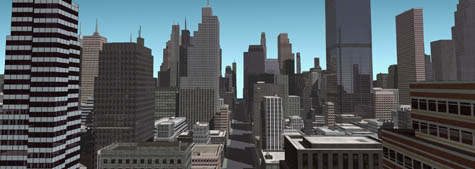 [Image: From Procedural Modeling of Cities by Yoav Parish and Pascal Müller].
[Image: From Procedural Modeling of Cities by Yoav Parish and Pascal Müller].
Note: This is a guest post by Jim Rossignol.
In 2001 Yoav Parish and Pascal Müller spoke at the SIGGRAPH conference in Los Angeles, California, to present a mathematical city. Their presentation contained an algorithmic approach for modeling city-like topologies. The results were remarkably realistic, and were one among a host of city-like generative systems to appear at the start of the decade.
Another, Jared Tarbell's Substrate (pictured) remains a fantastic example of how a mathematical approach to generating apparently urban patterns can also be artful.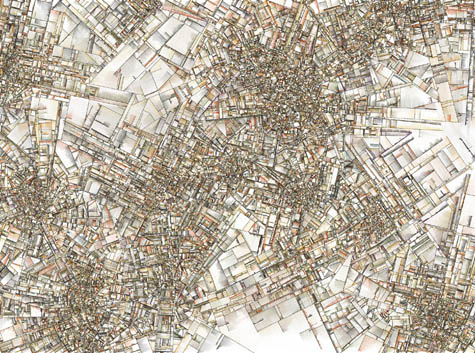 [Image: From Jared Tarbell's Substrate].
[Image: From Jared Tarbell's Substrate].
But it was looking at the work of Parish and Müller that inspired game designer Chris Delay to develop his most recent project: the cryptic (and as-yet-unexplained) Subversion, of which little is known, other than it relies on large, procedurally generated cities for the backbone of its game world.
Having already been burned by the problems of creating content "by hand," Delay set out to let algorithms do the work of building buildings in his new game. Not only that, but he was determined to create an artistically interesting experience without artists.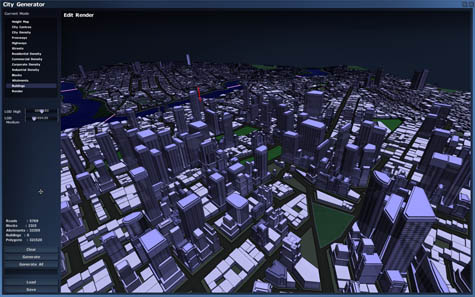
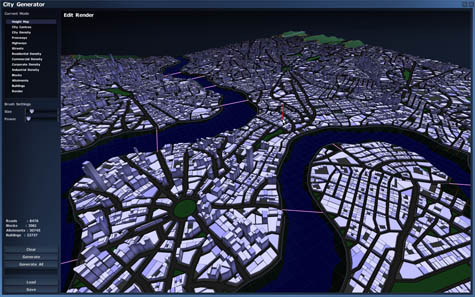 [Images: From Chris Delay's Subversion].
[Images: From Chris Delay's Subversion].
Of course, videogames have long been the home of procedurally generated landscapes where numbers and mathematical equations played the role of the visual designer. Early paranoid classic The Sentinel made use of these techniques to create an astonishingly atmospheric 10,000 levels in simple vector graphics, from just a few kilobytes of data. Other games have used similar techniques as a shortcut to creating solar systems and vast fractal landscapes.
But when it came to cities, well, it took a long time for anyone to take up the challenge. 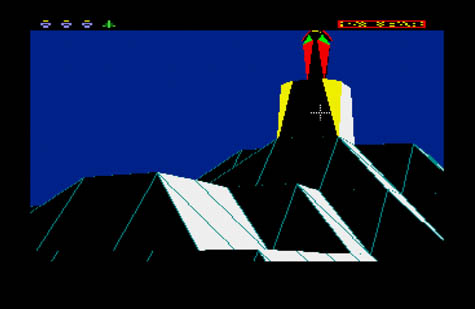 [Image: From The Sentinel by Geoff Crammond].
[Image: From The Sentinel by Geoff Crammond].
Rather than opt for procedural techniques, game designers usually elect to build their cities by hand, often with startling results. The re-imagined contemporary New York that features in last year's Grand Theft Auto 4 required a small army of well-paid artists and designers to hand-craft the entire world. Their accomplishment is unmatched, but the cost to the company behind the project is in the tens—and perhaps hundreds—of millions of dollars. To build up a living city from blank polygons is one of the most expensive possible projects in game design.
Delay, whose project is being undertaken with a tiny budget and by just a handful of staff based in Cambridge, UK, does not have the luxury of vast content teams. His vector-drawn city is far less realistic than Rockstar's textured, heaving metropolis, but there's nevertheless a beauty to it. It's a kind of mathematical map of the essential urban environment: there are roads, sidewalks, and a no-man's land of corporate moats around great skyscrapers...
Identify the key equation that define urban patterns, and you, too, can summon a city into existence.
Delay has begun to show off how his cities emerge from the ground up in a series of videos, and he spoke to me about the process.
"I started out with road layouts, and then began to modify the parameters," he explained. "Sometimes you'll get lovely radial, spiral patterns, or you can tell it to create a really rigid Manhattan-style grid." One set of numbers delivers the block logic of American cities, another is rather more like the spirals of Medieval European sprawls. The two merge to create something even more believable. "Every subsequent layer builds on the previous layer," Delay points out, "so the very next layer looks for the spaces between layers, and makes judgments about 'is this likely to be a skyscraper, or to be a house?' Then you zoom in, and carry on. You do another procedural generation process for each layer of detail, filling in that world." 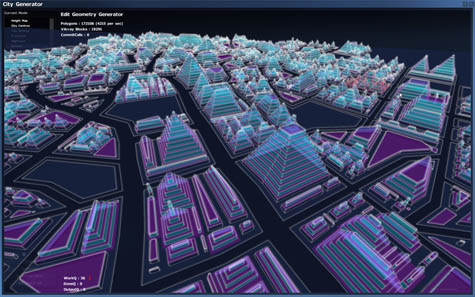 [Image: From Chris Delay's Subversion].
[Image: From Chris Delay's Subversion].
A few weeks after speaking with Delay I attended Thrilling Wonder Stories—a seminar at the Architectural Association in London, curated by Liam Young and BLDGBLOG—where I watched conceptual designer Viktor Antonov explain how he had created a science-fictionalized Paris (for a now-cancelled videogame called The Crossing).
Antonov approached the problem by altering just a few parameters in the standard architectural model. For instance, Antonov had noticed a few fundamental details about how the mid-nineteenth century neo-classical core of Paris had been constructed: big street-level floors, smaller attic spaces, complex chimney stacks. By increasing the emphasis on the lower floors, and stretching them out—and by emphasizing the height and complexity of the chimneys—Antonov was able to create a thematically consistent science fiction Paris.
Simply by altering a few basic architectural parameters, he said, you were able to fictionalize the city, whilst at the same time retaining its fundamental identity. His designs were still recognizably—even mathematically—Parisian, in other words, but they were also otherworldly.  [Image: By Viktor Antonov].
[Image: By Viktor Antonov].
This idea instantly connected back to Delay's project: what parameters would we need in order both to understand and create a science fiction Edinburgh, or Sao Paulo, or Vancouver? Identify the necessary fantasy logic within a procedural city-building system and you could recreate cities with their alternate identity in an instant. An accelerated future Moscow, or a retropunk Venice, instantly sprawling out of the monitor.
And perhaps this is not such an outlandish thing to aim for—especially when you consider the speed at which procedural city projects have been appearing across the tech landscape. Could one of these cities potentially be refitted to allow for this type of radical tweak?
Projects like Shamus Young's impressive PixelCity, or Marco Corbetta's Structure seem ripe for such strange fictions. Corbetta's system is particularly impressive in its verisimilitude: he aims to create a basic engine for rapidly generating the kinds of cities that games like Grand Theft Auto 4 require, and consequently doing so for much cheaper.
Could Corbetta's engine come with a Paris or a Barcelona preload, which could then be put through Photoshop-style filters for alternate reality logic in its architecture? A stronger skyline, weirder street furniture.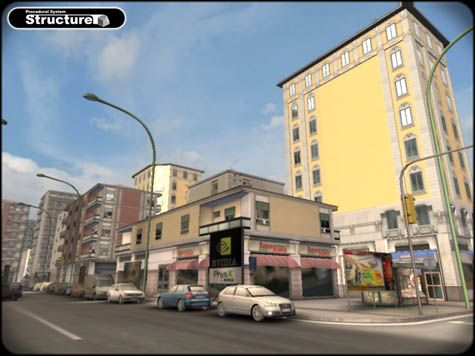 [Image: From Marco Corbetta's Structure].
[Image: From Marco Corbetta's Structure].
More exciting, at least for the thrill-seeking gamer in me, is the fact that Corbetta is aiming one notch higher than any of his peers: he's aiming to make these cities procedurally destructible. His site contains a demonstration video of neatly arrange office interiors and a domestic library being blown to pieces with a machine-gun. What good is an imaginary city if you can't go inside the buildings? What good is a virtual downtown if you can't go crazy with a bazooka? Corbetta's work preempts these questions.
Further, it conjures visions of massive demolition exercises in parallel worlds—entering an Antonov-algorithm for neo-Rome, where gladiatorial escapades see us going through the walls of the coliseum and into the randomly generated plazas beyond.
That, perhaps, is the greatest promise of procedural cities: that soon they'll be real enough that their destruction will seem like tragedy.
[Jim Rossignol is a games critic for Offworld, an editor at Rock, Paper, Shotgun, and the author of the fantastic This Gaming Life: Travels in Three Cities. A full-length interview with Rossignol appeared on BLDGBLOG in May, and he has written a previous guest post, Evil Lair: On the Architecture of the Enemy in Videogame Worlds].
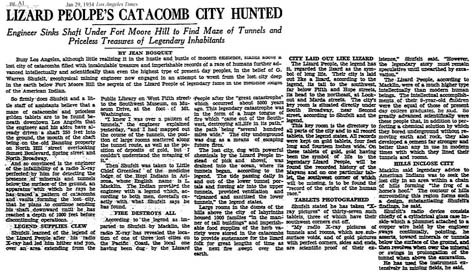 [Image: View larger].
[Image: View larger].
Last week, Josh Williams, formerly of Curbed LA, emailed with an amazing link to an article, reportedly published back in 1934 by the L.A. Times, about a race of "lizard people" who once lived beneath the city.
"Did strange people live under site of Los Angeles 5000 years ago?" the article asks, supplying a bizarre treasure map through the city's undersides in the process. 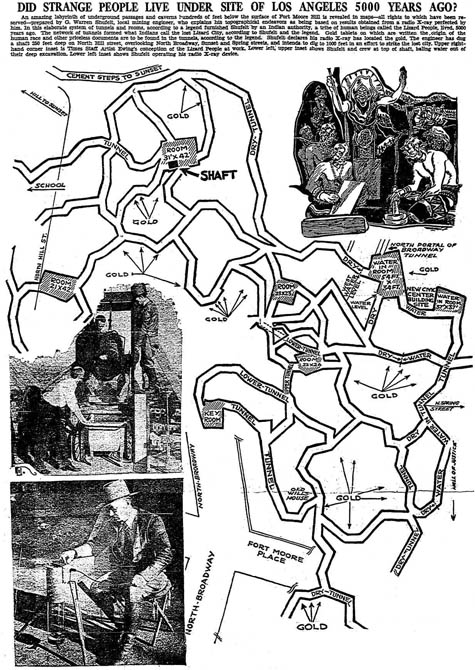 [Image: View larger].
[Image: View larger].
Although you can read the article in full through these links, I wanted to give you a taste of the story's strange mix of gonzo archaeology, Poltergeist-like pre-Columbian cultural anxiety, and start-up geophysical investigation squad:
- So firmly does [a "geophysical mining engineer" named G. Warren Shufelt] believe that a maze of catacombs and priceless golden tablets are to be found beneath downtown Los Angeles that the engineer and his aides have already driven a shaft 250 feet into the ground, the mouth of the shaft behind on the the old Banning property on North Hill Street overlooking Sunset Boulevard, Spring Street and North Broadway.
And so convinced is the engineer of the infallibility of a radio X-ray perfected by him for detecting the presence of minerals and tunnels below the surface of the ground, an apparatus with which he says he has traced a pattern of catacombs and vaults forming the lost city, that he plans to continue sending his shaft downward until he has reached a depth of 1000 feet before discontinuing operations.
"I knew I was over a pattern of tunnels," Shufelt is quoted, "and I had mapped out the course of the tunnels, the position of large rooms scattered along the tunnel route, as well as the position of the deposits of gold, but I couldn't understand the meaning of it."
Perhaps this is what we'd get if Steven Spielberg hired Mike Mignola to write the next installment of Indiana Jones.
(Thanks to Josh Williams, and to vokoban, who originally uploaded the scan. Vaguely related: The Hollow Hills and Mysterious Chinese Tunnels).

Over the past ten weeks it has rained here alot. I know this for an indisputable fact.
Why?
Because chances are I've been out running in it.
And many, many times as I've panted up hills or woken up the next morning with my muscles screaming at me, I've wondered why I was doing it.
But I had a very good set of reasons.
1. Health
2. Weight loss (4.5 kg thank you very much)
3. Remembering precious souls.
Sunday morning is race day.
Again I want to thank Lauren for this idea. Sticking to this running training is what has kept me healthy and whole during some trying times recently.
I'm seriously considering training for a half marathon for next year because this has been so good for me.
And this is the picture I had transferred onto the back of my shirt for the run on Sunday. Hope y'all like it!
I'll be posting a more in depth story about the run afterwards, though you can follow me on Twitter as I send regular updates throughout the morning!
Wish me luck (and energy and speed)
ETA if anyone would like a copy of the sunflower, please let me know and I'll happily email you the JPEG xxxx
I was riding along the Donaukanal near Winterhafen and came upon a large brown horse blocking the path. I say large – it looked large but I was on a bicycle – perhaps it was just a normal sized horse.
It was standing still in the middle of the path. There was no way around it. On the back of the horse sat a woman – who was talking on a Handy. Both horse and rider were aware of my existence but were unconcerned – and unmoved.
I imagine the woman was having a conversation along the lines of
‘yes, I’m on the horse’
‘on the Donaukanal near Winterhafen’
‘oh she’s fine – enjoying the day out – aren’t you darling’ (pats horse)
‘about an hour or so’
‘what sort of milk do you want – I will have to go to the Billa at Simmering - you can take horses in there’
'OK I'll just let Dobbin defecate on the bike path some more and then come home'
Clearly there was nothing for it but to tackle the task so I approached cautiously.
I had in mind that you don’t go behind horses. Someone told me that. It might have been Roy Rogers. I had a small part (uncredited) in one of his last films, ‘South of Caliente’ and he used to tell me things about horses. (I was very young at the time - I played the part of Munzie - a small dim child - perfect role for me really).
I think he said if you walk behind a horse that you don’t know it may kick you and – depending where it got you – there were varying degrees of incapacitation involved.
He told me that a wrangler named Larry Larsen had been kicked by a horse when he was making a movie in Monument Valley in the 30s and was in a coma for days - and was never the full quid again. Ended his days as a Republican Senator in Nevada.
It was in fact Roy who first aroused my interest in quilting. He didn’t do Koalas of course and for him it was almost exclusively horses and Indians. He was fascinated by the headdresses – although these were bloody hard to do - have you ever tried to do a feather?
Of course in those days movies were not about sitting around waiting for the set up like they are now. It was all jump on a horse, ride, shoot somebody, have a drink in a bar, sing a song, jump on a horse, ride etc.
Bearing Roy’s advice in mind I headed for the front of the horse – wondering whether Roy had ever mentioned horses biting and what sort of damage they could do – quite a bit I imagine – they have startling teeth – some of them would give Julia Roberts a run for her money.
The rider glared at me balefully as she carried on her conversation - but the horse showed no interest. For a moment I wished I was the horse. I would have thrown the rider off and booted her across to the other side of the Donaukanal.
I sort of eased my way under her head – admiring her magnificent teeth (the horse not the rider) and scuttled off without further incident.
Winter came early yesterday. While I was riding Sissi found a roll of paper towels and turned them into snow. Very picturesque it was – I am going to get her to decorate the Christmas tree.
Not content with tearing the remaining Hedge tree to pieces Sissi now sleeps in it. This is bizarre behaviour indeed.
I regret to advise that Toni Sailer has died. Toni was Austria’s best ever skier and one of the greatest of all time. I watched a documentary about him fairly recently. Read about him here
You will note that (after further coaching from Merisi) my links are opening on new pages. This is a great leap forward in the evolution of the Blog.
I hope to have it perfected before the last reader leaves.
Just before Winter – a new horror has emerged in the wilds of Austria. Hordes of killer wasps are sweeping across the country stinging their victims to death and devouring small children.
As reported by the Austrian Times:
“An Upper Austrian chef was hospitalised after a wasp stung him in the mouth.
The 33-year-old failed to see the wasp fly into his drink as he swigged away at a restaurant yesterday (Mon) in Gmunden, Upper Austria.
He soon started to complain of feeling sick and emergency services called in by the restaurant’s owner took him to hospital with a suspected allergic reaction to the sting.
Experts say wasp stings can be fatal if people are stung in the mouth or throat and swelling causes them to suffocate or if the victims develop extreme allergic reactions.
Only last week a 70-year-old Upper Austrian man died three days after he was stung on the lip by a wasp and a 77-year-old Styrian woman died of a heart attack two weeks ago after she was stung by wasps. Doctors said pensioner Rosi Hofbauer from Langenwang in Mürzzuschlag district died from an allergic reaction when she was stung on the back of her head and neck.
And a 45-year-old woman from Traun, Upper Austria, died three weeks ago of circulatory failure caused by an allergic reaction to a wasp sting one week before.
Also early this month, Upper Austrian Social Democratic (SPÖ) councillor Josef Nigl, 60, died after he was attacked by hundreds of wasps when he disturbed their nest as he cut down trees with a friend in Schlägl in Rohrbach district.
What next? The attack of the Killer Igels?
Perhaps Austria is not so safe after all.
Apparently she and the other Infidels are locked in a separate room with a sandwich and a bottle of water and told to eat quietly lest they offend the faithful.
Needless to say she is looking forward to getting home.
So far today Sissi has not escaped. The man arrived very early this morning and put new glass (with holes) in the study windows. As soon as the glue dries I can install the air coolers. This will stop hot air from getting in and small cats from getting out.
Yesterday I was cycling again in the teeth of a howling gale but when I got home I checked the Internet to find that the wind was only 10 kph. I just don’t believe it.
I have ordered a bicycle speedometer so that I can see how far I travel. I think my usual trip is about 30 kilometers – with another 10 kilometers for the extended leg – but I really am not sure as – because I do not use normal roads – I cannot measure it precisely on Google maps.
On the theme that everything of note happens in Vienna I report that Danica Johnson (who says she lives here) – lost 47 Pounds (yes 47 – as much as Kylie Minogue weighs wringing wet) by following a regime which included some completely useless detox products invented by charlatans as a way of sucking money out of the ever gullible public.
You can read Danica's fascinating story at Danica's Story
Can you imaging how much weight she would have lost if the products were efficacious!
Without wishing to put too much of a dampener on your new found enthusiasm for these products – before ringing with your credit card number you should read this link
You may have noticed how sceptical I am about so many things these days. It’s just that the older I get the more I learn and the more I learn the more I realise that I have been gulled by many people many times over many years. Well this is it – you are just not going to have Dick to kick around anymore (where have I heard that before?)
On Austrian TV they advertise something called the Abtronic which is an electronic device which you strap to your stomach and it takes weight off, tones your muscles, cures gout and trims nose hair.
You don’t believe me do you? Hmmm…..neither do many others.
Look here
The only thing surprising about this is if that Austrians still allow this stuff to be sold to the punters. But – any country that encourages young people to smoke - and cyclists and skiers not to wear helmets - really doesn’t give a toss.
A little porch moth, anyone?
A small, interesting spider, with all her worldly possessions arranged on either side of her.
This guy was at the edge of her web. Not sure if it's her hubby or just some interloper.
I'm almost certain that this late instar mantid nymph is the same one from this post.
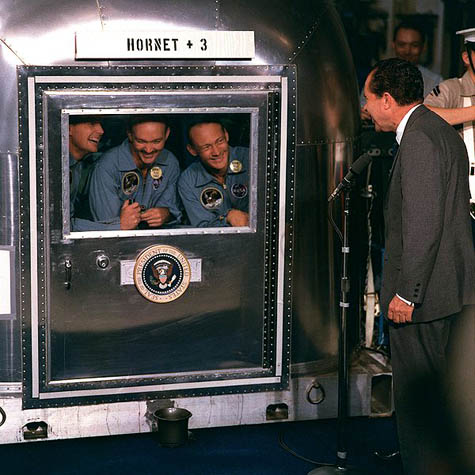 [Image: President Nixon addresses quarantined astronauts from the Apollo program; via NASA].
[Image: President Nixon addresses quarantined astronauts from the Apollo program; via NASA].
I'm incredibly excited to announce not only that BLDGBLOG will be living in New York City this fall, but that my wife and I will be hosting a design studio there called Landscapes of Quarantine – the results of which will be the subject of a public exhibition at Storefront for Art and Architecture in early 2010.
Meeting one evening a week this autumn in Manhattan, from October 6 to December 5, 2009, up to 14 studio participants will discuss the spatial implications of quarantine, each developing an individual design project in response to the studio theme.
Quarantine is both an ancient spatial practice and a state of monitored isolation, dating back at least to the Black Death – if not to Christ's 40 days in the desert – yet it has re-emerged today as an issue of urgent biological, political, and even architectural importance in an era of global tourism and flu pandemics.  [Image: "Fear of Flu" by Mike Licht].
[Image: "Fear of Flu" by Mike Licht].
Quarantine touches on serious constitutional issues associated with involuntary medical isolation, as well as on questions of governmental authority, regional jurisdiction, and the limits of inter-state cooperation. Quarantine is as much a matter of national security, public safety, and agricultural biodiversity as it is an entry point into discussions of race, purity, and unacknowledged discrimination.
Quarantine is also a plot device increasingly seen in novels and films – from the aptly named Quarantine and Albert Camus's The Plague to I Am Legend and The Last Town on Earth – even as it has become a source of arcane technical debate within plans for Martian exploration and Antarctic drilling rights.
The design implications of quarantine stretch from the ballast water of ships to the way we shape our cities, from the clothes in travelers' suitcases to stray seeds stuck in the boot treads of hikers. Quarantine affects the pets we keep, the programs we download, and the machines we use in food-processing warehouses, worldwide.
Quarantine is about managing perimeters, controlling influence, and stopping contamination. 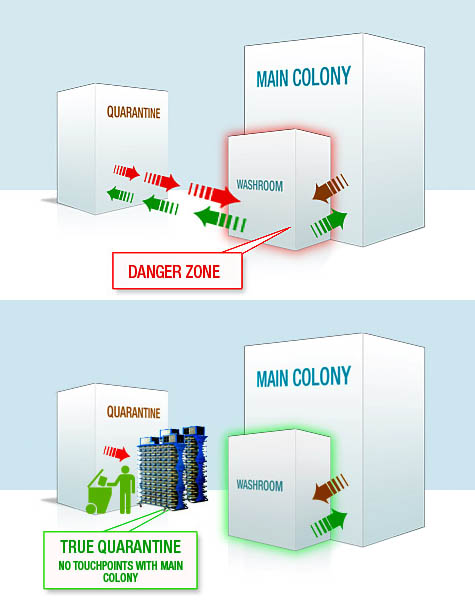 [Image: Cages for the laboratory testing of rats and mice by Innovive].
[Image: Cages for the laboratory testing of rats and mice by Innovive].
So how do we treat quarantine as a design problem?
Whether we design something to demonstrate that the very notion of quarantine might not be possible; whether we produce actionable plans for quarantine units, ready for implementation by the World Health Organization in hot zones around the world; whether we create quarantine-themed graphic novels, barrier-based urban games, or a series of ironic public health posters to be mounted around the city, how can we design for quarantine?
Quarantine also offers fertile territory for investigation through cartography and cultural documentation. After all, if we mapped the contents and locations of quarantine facilities worldwide, designed infographics to analyze the spread of invasive species, or recorded the oral histories of the quarantined, what sorts of issues might we uncover?
Bringing these very different techniques, media, and approaches together in the confines of a dedicated design studio will give participants an exciting opportunity to explore the overlooked spatial implications of quarantine.  [Image: A poster for Quarantine, directed by John Erick Dowdle].
[Image: A poster for Quarantine, directed by John Erick Dowdle].
We have already confirmed a fantastic list of participants, whose backgrounds include architecture, photography, illustration, games design, sound, landscape, food, and more; we are now opening the studio to a general call for interested participants.
The brief – which you can download here as a PDF or that you read as a JPG on Flickr – explains more; but potential applicants will be working with a truly stellar group as they meet once a week this fall and produce work eligible for inclusion in the "Landscapes of Quarantine" exhibition to be held at Storefront for Art and Architecture in early 2010.
If you are interested, please download the brief – which includes all necessary application info – and contact us at futureplural @ gmail by September 19, 2009. [Image: Australian quarantine signage].
[Image: Australian quarantine signage].
For ease of reference, I have decided to include the studio brief in full below:
- Landscapes of Quarantine is an independent, multi-disciplinary design studio, based in New York City, consisting of eight Tuesday evening workshops, from October 6 to December 5, 2009, in which up to 14 participants will gather to discuss the spatial implications of quarantine. Quarantine is an ancient spatial practice characterized by a state of enforced immobility, decontamination, and sequestration; yet it is increasingly relevant—and difficult to monitor—in an era of global trade, bio-engineering, and mass tourism.
Studio participants will explore a wide variety of spatial and historical examples, including airport quarantine facilities, Level 5 biohazard wards, invasive species, agricultural regulations, swine-flu infected tourists confined to their hotel rooms, lawsuits over citizens' rights to resist involuntary quarantine, horror films, World Health Organization plans for controlling the spread of pandemics, lunar soil samples, and more.
During the studio, participants will develop individual design projects in response to the problem of quarantine, with guidance and inspiration provided by readings, screenings, group discussions, and an evolving line-up of guest speakers and critics. These projects will then be eligible for inclusion in "Landscapes of Quarantine,” an exhibition hosted by the internationally renowned Storefront for Art and Architecture in early 2010.
By the end of the studio, each participant will have produced a complete design project. This could range from the speculative (plug-in biosecurity rooms for the American suburbs) to the documentary (recording the items and animals detained for quarantine on the U.S./Mexico border), and from the fantastical (plans for extra-planetary quarantine facilities) to the instructional (a field guide to invasive species control).
Landscapes of Quarantine is looking for applicants who are intrigued by the spatial possibilities and contingencies of quarantine, and who already possess the technical skills necessary to produce an exhibition-quality final design project or installation in their chosen medium. We hope to hear from people at all stages of their careers—from graduate school to retirees—and from a wide variety of design backgrounds. We are particularly excited to announce that we have already confirmed a select group of talented participants from fields as diverse as architecture, illustration, gaming, photography, and sound design.
The studio is both unaffiliated and independent (there is no college credit), and it is also free (though applicants will be responsible for all costs associated with producing their final project). We will be reviewing applications on a rolling basis until Friday, September 18, 2009, or until all studio positions have been filled. To learn more, and to submit an application, please email futureplural @ gmail with the information listed below.
- 1) Name
2) Email address
3) Telephone number(s)
Please indicate the best time to reach you
4) Mailing address
5) Education
• University/college name and country
• Dates attended
• Degree
6) Current affiliations and/or employment
7) 50-word (maximum) bio
8) Publications and/or personal blog
9) Portfolio
Attach a PDF of no more than 8 pages, or supply a link to online work
10) 300-word (maximum) statement of interest in the topic of quarantine
11) Candidate’s declaration
By submitting your application, you declare the following:
• I certify that the work submitted is entirely my own and/or my role is clearly stated
• I declare that all the statements I have provided are correct
• I agree that, if accepted into the studio, I will participate fully, attend all studio meetings unless previously discussed with the studio directors, and produce a finished final design project
12) Email addresses for two references
Landscapes of Quarantine is produced and organized by Future Plural, a project-based, independent design lab launching in October 2009 from a temporary base in New York City. Future Plural is Geoff Manaugh (BLDGBLOG) and Nicola Twilley (Edible Geography).
Lưu trữ Blog
-
▼
2009
(1255)
-
▼
tháng 8
(109)
- August Spending/Miles
- Jause - what a great idea that is!
- Digital Architecture London
- Optioning Architecture
- Perth City to Surf 2009 Wrap Up
- Last Chance To See: TV Series Episode 1 - Amazonia...
- Clockwiser Android credits
- Mummy Mania
- Week Ending August 30
- Dr. Dia Paravan
- Playlist - 29th August 2009
- Last Chance To See TV Series: Mail On Sunday Feature
- Procedural Destruction and the Algorithmic Fiction...
- City Laid Out Like Lizard
- Jog Blog- the final countdown
- The attack of the Killer Igels is coming!
- Eat quietly and leave no crumbs - Infidel!
- Back to the usual suspects
- Landscapes of Quarantine: Call for Applications
- Horsetooth Rock FKT Attempt
- Are the Ashes important?
- Holiday Monster
- Leadville '09
- US Seismic Ship Heading to Canadian Waters
- Did I mention that I was naked?
- The Edge
- Wordpower
- Dissection of a Cathedral
- City of Fees and Services
- Week Ending Aug 23
- Playlist - 22nd August 2009
- My Utah trip on Flickr
- Lep-stuff from Utah
- Weeping walls, hanging gardens
- In the water: above and below
- More from Utah...in the water
- Superbowl XXXVII
- Honeybee Awareness Day
- Utah beetles
- Zion mystery pupae
- Utah grasshopper diversity
- Smaller spiders
- Tarantula wasps, and...
- Behind the motel, milkweed visitors
- There were plenty of ants.
- Utah mantids
- Health Care Lies Go International - Have Your Say
- The Bioluminescent Metropolis
- Scuba Diving Beneath Hagia Sophia
- The fountain
- Well of course - Apple lives in Cupertino!
- On Publishing Student Work
- Leadville 100 Predictions
- Why Cupertino CA?
- Back from Vacation
- To do
- We now have padded bottoms
- My wife and I are sitting in Sydney International ...
- I don't want to know what's in a Wurstel
- Doors, Thirds, Bridges, and Pools
- Week Ending August 16
- Pikes Peak Ascent - Bubble Boy
- Playlist - 15th August 2009
- Army #2
- President Obama does not murder Otters
- The gloved one
- Lawsuit Against US Seismic Blasting in Canadian Wa...
- Pikes Peak preview
- Stephen Fry: New Scientist Interview
- Architecture is always a way of envisioning our wo...
- Ben will need a Burqa
- Future Pastoral
- Building air castles
- Last Chance To See - TV Series Begins Sunday, 6th ...
- just had a caramel cream frappachino DELISHHH!!!
- Xbox LIVE Update
- How you doing?
- Style-o-rama
- We're off on an adventure
- Dark fence wood camouflage moth
- The Most Intelligent Emissions Target, Period
- What to do when you have error 99
- Excavatory Improv
- Longs Peak
- Week Ending Aug 9
- Graphic Analysis
- An Alpine Gold Rush
- Playlist - 8th August 2009 - Funkology
- On a sunny morning in Cairns, I'm flying back into...
- The unexpected
- Feds Announce New Standards for Sewage
- Open Internet Explained
- horse
- Where is Ricky's mother?
- Home cinema
- Goodbye My Friends
- Not a bad result for a handful of feathers
- Cartoons...
- Sissi wants to be a Lumberjack
- “Lost,” “Grey’s Anatomy,” “Desperate Housewives” a...
-
▼
tháng 8
(109)






